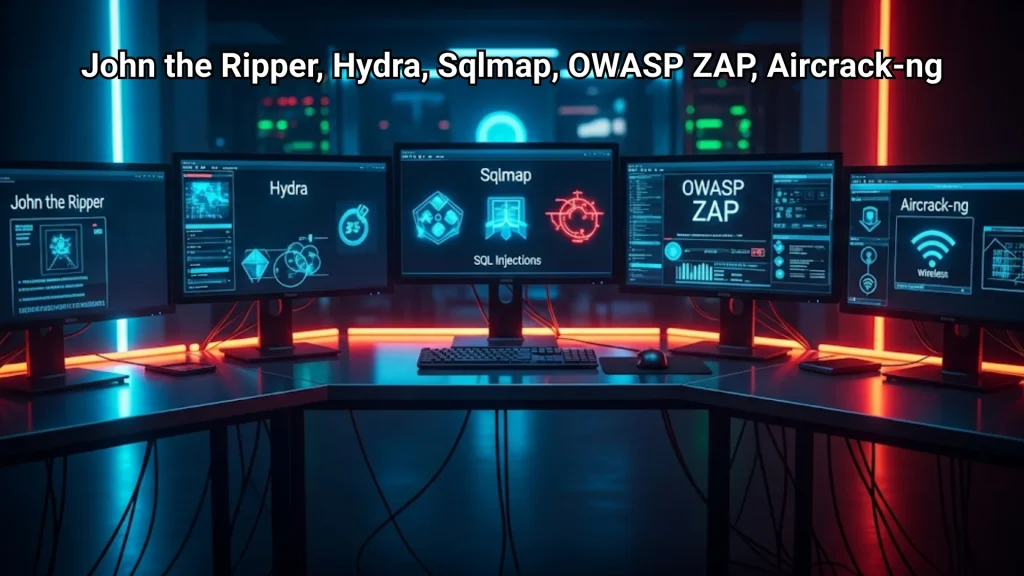In today’s digital landscape, free penetration testing tools are essential as cybersecurity threats become more sophisticated than ever. Organizations, startups, and even individual developers need to proactively identify vulnerabilities before attackers exploit them. Penetration testing, also called pen testing, is the practice of simulating cyberattacks to uncover weaknesses in systems, networks, or applications.
For both beginners and experienced cybersecurity professionals, these free penetration testing tools offer an accessible and cost-effective way to perform robust security assessments. In this comprehensive guide, we’ll explore the top 10 tools for penetration testing in 2025, their practical applications, best practices, and ethical considerations.
What Is Penetration Testing?
Penetration testing is a simulated attack performed on a system to evaluate its security. Unlike vulnerability scanning, which simply identifies potential weaknesses, pen testing goes a step further—it tests whether vulnerabilities can actually be exploited.
| Stage | Description | Common Tools |
| Reconnaissance | Gathering information about the target system | Nmap, Wireshark |
| Scanning | Identifying potential vulnerabilities | Nikto, OWASP ZAP, Sqlmap |
| Exploitation | Safely exploiting weaknesses to validate risk | Metasploit, Burp Suite |
| Reporting | Documenting findings with severity and recommendations | Manual documentation or reporting tools |
Pen testing is not only about discovering flaws—it helps security teams prioritize risks, strengthen defenses, and improve incident response strategies. Using free penetration testing tools, testers can learn and practice without financial constraints.
Graphic suggestion: Flowchart showing the stages from Reconnaissance → Scanning → Exploitation → Reporting, with small icons for each stage.
Why Open-Source Tools Are Important

Open-source tools are a cornerstone of cybersecurity. Their importance lies in:
- Cost-Efficiency: Free tools allow students, startups, and small teams to practice pen testing without expensive software licenses.
- Transparency: Publicly available source code ensures no hidden backdoors exist.
- Community Support: Active communities provide updates, tutorials, and troubleshooting help.
- Customizability: Security teams can adapt tools to their unique testing needs.
Open-Source vs Paid Tools
| Feature | Open-Source Tools | Paid Tools |
| Cost | Free | $100–$5000+ |
| Community Support | Large & active | Vendor-dependent |
| Updates | Frequent | May require subscription |
| Customization | High | Limited |
| Learning Opportunities | Excellent | Moderate |
By leveraging free penetration testing tools, professionals can gain practical experience, contribute to tool development, and stay updated with emerging threats.
Top 10 Free Penetration Testing Tools List
In 2025, cybersecurity professionals don’t rely on just one type of Free Penetration Testing Tools — they need a mix that covers networks, websites, passwords, and even wireless connections. To help you navigate this complex landscape, we’ve put together a detailed guide to the top 10 free tools that every pen tester should know. We’ve grouped them by functionality so you can easily understand what each tool is best for and when to use it in a real-world scenario.In 2025, cybersecurity professionals rely heavily on a mix of network, web, password, and wireless testing tools. Below is a detailed guide to the top 10 tools every pen tester should know, grouped by functionality.
Nmap, Nikto, Metasploit, Burp Suite, Wireshark
1.Nmap (Network Mapper)
Nmap is a network scanning tool used to discover hosts, open ports, and services. It can even infer operating systems and detect firewall rules.
Use Cases:
- Mapping internal and external networks
- Discovering unauthorized devices
- Identifying potential vulnerabilities
2.Nikto
Nikto is a web server vulnerability scanner. It can detect outdated software, insecure files, and configuration issues.
Use Cases:
- Scanning public websites for known vulnerabilities
- Automating routine web security checks
Metasploit is a comprehensive exploitation framework. It allows testers to simulate attacks safely, test payloads, and learn real-world attack strategies.
Use Cases:
- Exploiting known vulnerabilities in lab environments
- Conducting security assessments for clients
4.Burp Suite (Community Edition)
Burp Suite is a web application testing tool that intercepts HTTP requests, performs automated scanning, and helps find vulnerabilities like SQL injection and XSS.
Use Cases:
- Web application penetration testing
- Manual and automated vulnerability analysis
Wireshark captures and analyzes network traffic, helping testers understand protocol-level details, detect suspicious activity, or identify unencrypted sensitive data.
Use Cases:
- Packet-level network analysis
- Detecting network misconfigurations or attacks
John the Ripper, Hydra, Sqlmap, OWASP ZAP, Aircrack-ng

A password-cracking tool that tests password strength using dictionary and brute-force attacks.
Use Cases:
- Auditing password security internally
- Testing system resilience against weak passwords
7.Hydra
Hydra automates brute-force login attempts for multiple protocols. It is ideal for testing weak credentials in networks.
Use Cases:
- Network authentication testing
- Multi-protocol penetration assessments
8.Sqlmap
Sqlmap automates detection and exploitation of SQL injection vulnerabilities. It can extract database information to test security rigor.
Use Cases:
- Web application database security testing
- Auditing forms and input fields for injection points
9.OWASP ZAP (Zed Attack Proxy)
ZAP scans web applications for security vulnerabilities. Its active and passive scanning features help detect security issues with minimal setup.
Use Cases:
- Regression security testing of web apps
- Detecting XSS, SQL injection, and broken authentication
10.Aircrack-ng
Focused on wireless network security, Aircrack-ng captures packets, analyzes encryption, and attempts to crack weak Wi-Fi passwords.
Use Cases:
- Assessing Wi-Fi network security
- Testing encryption strength of wireless access points
Table: Feature Comparison of Top 10 Tools
| Tool | Type | Key Features | Best For |
| Nmap | Network | OS detection, host discovery | Network mapping |
| Nikto | Web | Vulnerability detection | Web servers |
| Metasploit | Exploitation | Payloads, exploits | Vulnerability verification |
| Burp Suite | Web | Traffic interception, XSS/SQLi | Web apps |
| Wireshark | Network | Packet capture, analysis | Traffic inspection |
| John the Ripper | Password | Dictionary, brute-force | Credential audits |
| Hydra | Password | Multi-protocol brute-force | Login security |
| Sqlmap | Web | Automated SQLi detection | Database testing |
| OWASP ZAP | Web | Active/passive scanning | Web security |
| Aircrack-ng | Wireless | Packet capture, cracking | Wi-Fi security |
When and How to Use Each Free Penetration Testing Tools

Understanding proper usage is critical:
- Reconnaissance: Nmap, Wireshark
- Web Application Testing: Nikto, Burp Suite, OWASP ZAP, Sqlmap
- Password Audits: John the Ripper, Hydra
- Exploitation: Metasploit
- Wireless Testing: Aircrack-ng
Tips:
- Start with passive scans to avoid system disruptions.
- Combine tools for layered security testing.
- Document everything for reproducibility and ethical reporting.
Graphic suggestion: Flowchart showing tool workflow from reconnaissance → scanning → exploitation → reporting.
Ethical Guidelines for Pen Testers
Ethics are non-negotiable in cybersecurity:
- Obtain Permission: Only test authorized systems.
- Avoid Disruption: Never harm production systems.
- Maintain Confidentiality: Share results responsibly.
- Report Accurately: Provide actionable recommendations and evidence.
Adhering to these principles ensures legal compliance and professional integrity.
FAQs
Q1: Are free tools enough for penetration testing?
Yes, free penetration testing tools are sufficient for most beginner and intermediate tests. Enterprise environments may require advanced paid tools for large-scale assessments.
Q2: Which OS is best for running free penetration testing tools tools?
Linux distributions such as Kali Linux or Parrot Security OS are recommended. They come preloaded with most essential open-source tools.
Q3: Can I use free penetration testing tools legally?
Only on systems you own or have explicit authorization to test. Unauthorized usage is illegal and could result in severe penalties.
Q4: How can I maximize the effectiveness of free penetration testing tools?
To maximize the effectiveness of free penetration testing tools, it’s crucial to stay updated with the latest versions, combine different tools for layered testing, and document findings for future reference. Regular practice and joining cybersecurity communities can also enhance your skills and ensure you are using these tools efficiently.
Take Your Cybersecurity Skills to the Next Level
Mastering free penetration testing tools is vital in 2025. From Nmap and Metasploit to OWASP ZAP and Aircrack-ng, these tools help testers identify vulnerabilities, strengthen defenses, and enhance cybersecurity skills.
By leveraging open-source solutions, following ethical guidelines, and documenting findings, you can ensure effective and responsible pen testing. Start experimenting today in safe, legal environments and keep your skills sharp in an ever-evolving cybersecurity landscape.
Ready to take your cybersecurity skills to the next level? At Bilişim Academy, we offer hands-on courses and workshops that teach you how to master free penetration testing tools and ethical hacking in real-world scenarios. Start learning today and become a certified cybersecurity professional with practical skills that employers value.
In collaboration with our trusted SEO and Media Planning partner, we ensure our programs reach the right audience across digital platforms—so you can be confident you’re learning from a globally recognized and widely respected institution.




